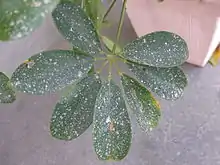Rain dust
Rain dust or snow dust, traditionally known as muddy rain, red rain, or coloured rain, is a variety of rain (or any other form of precipitation) which contains enough desert dust for the dust to be visible without using a microscope.

History
The rain dust phenomenon was studied by Italian scientist Giuseppe Maria Giovene (1753–1837), who managed to correctly explain the phenomenon as early as 1803. On 7 March 1803, rain dust fell over Southern Italy's region Apulia. At that time, people believed that the rain was caused by the explosions of Italy's volcanoes Mount Vesuvius or Etna, or that it was due to the transport of matter coming from the sea floor and raised by vapor. Giuseppe Maria Giovene related the phenomenon to the wind which occurred prior to the rain event, and he came to the conclusion that the sand had come from Africa and that it had been pushed by the wind coming from south-east.[1][2]
Geography
Rain dust is common in the Western and Southern Mediterranean, where the dust supply comes from the atmospheric depressions going through the northern part of North Africa. The main sources of desert dust reach the Iberian Peninsula and the Balearic Islands in the form of dust transported by wind or rain from the Sahara, Atlas Mountains in Morocco and Central Algeria.[3]
Mud rains are relatively frequent and had been increasing in early 1990s in the Mediterranean Basin.[4]
It also occurs in arid desert regions of North America such as west Texas or Arizona. It occasionally happens in the grasslands as it did in Bexar County, Texas on March 18, 2008.
Dust composition
The rain dust is very alkaline.[3] Some of the large particles contain mixtures of chemicals such as sulfate and sea salt (chiefly with sodium, chlorine and magnesium). Major minerals in order of decreasing abundance are: illite, quartz, smectite, palygorskite, kaolinite, calcite, dolomite and feldspars.[3] In Majorca a study finds that the size, by volume, 89% of the particles from rain dust fraction corresponded to silt (between 0.002 mm and 0.063 mm) and that there was virtually no clay sized particles (less than 0.29%).[5]
Researchers from Hacettepe University have reported that Saharan soil may have bio-available iron and also some essential macro and micro nutrient elements suitable for use as fertilizer for growing wheat. It has been shown that Saharan soil may have the potential of producing bioavailable iron when illuminated with visible light and also it has some essential macro and micro nutrient elements. Saharan soil samples analyzed by x-ray diffraction reveal the dominant minerals are quartz, feldspar, calcite, gypsum and clay.[6]
Importance
- The particulates that rain dust carries are important for the formation of long-term soil counteracting, in large part, the effects of soil erosion. The amount of solids in rain dust have been estimated at 5.3 grams per m2 (in a study made in Montseny, Catalonia) in this location the dust provides 34% of the calcium needed by the holm oak. The amount of the deposition of dust particles is highly variable depending on the year.
- Saharan dust significantly increases the pH of rain water. This may counteract the effects of acid rain.
- Radioactivity from the Chernobyl disaster was carried by rain dust to Greece in 2000.[7]
Blood/red rain
Rain dust is the most common cause of blood rain.
Red rain is however not always rain dust, see for example the Red rain in Kerala.
References
| Wikimedia Commons has media related to Sand rain. |
- elogio-storico, pag. 20
- pioggia-rossa
- Avila, Anna; Queralt-Mitjans, Ignasi; Alarcón, Marta (1997). "Mineralogical composition of African dust delivered by red rains over northeastern Spain". Journal of Geophysical Research. 102: 21977–21996. Bibcode:1997JGR...10221977A. doi:10.1029/97JD00485.
- Sala, José Quereda; Cantos, Jorge Olcina; Chiva, Enrique Montón (1996). "Red dust rain within the Spanish Mediterranean area". Climatic Change. 32 (2): 215. Bibcode:1996ClCh...32..215S. doi:10.1007/BF00143711. S2CID 154475201.
- Fornós, Joan J., Crespí, Damià; Fiol, Lluís (1997). "Aspectes mineralogics i texturals de la pols procedent de les pluges de 1ang a les IIles Balears: la seva importancia en alguns processos geologics recents". Boll. Soc. Hist. Nat. Balears. 40: 114–122.CS1 maint: multiple names: authors list (link)
- Yücekutlu, Nihal; Terzioğlu, Serpil; Saydam, Cemal; Bildacı, Işık (2011)."Organic Farming By Using Saharan Soil: Could It Be An Alternative To Fertilizers?" Hacettepe Journal of Biology and Chemistry. 39 (1): 29–38.
- Papastefanou, C; Manolopoulou, M; Stoulos, S; Ioannidou, A; Gerasopoulos, E (2001). "Coloured rain dust from Sahara Desert is still radioactive". Journal of Environmental Radioactivity. 55 (1): 109–112. doi:10.1016/S0265-931X(00)00182-X. PMID 11381550.
Bibliography
- Andrea Tripaldi (1841). "Elogio storico del canonico arciprete Giuseppe Maria Giovene". Memorie di matematica e di fisica della Società italiana delle scienze residente in Modena. Modena: Tipi della R. D. Camera. 22.
- Giuseppe Maria Giovene (1803). Lettera su di una pioggia rossa.